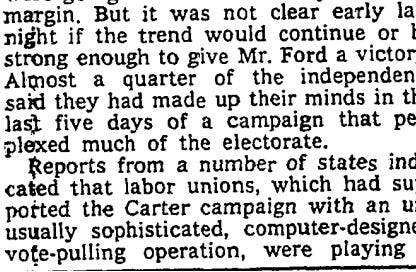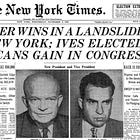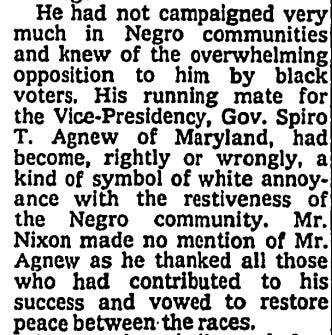Grading historical takes, the Cold War and Unipolar Eras
Were political reporters always out of touch?
Last week we started a series looking at the initial explanations for elections from 1852 to 2024 to get a baseline for how we should be judging the recriminations and credit happing today.
You can read more about why I’m spending so much time on old issues of the New York Times here:
Let’s pick up where we left off, with Bill Clinton’s re-election, and head back in time to when people liked Ike.
1996
“The 50-year-old Mr. Clinton offered himself as a vigorous leader for a new century, but the success of his campaign turned largely on his ability to seize a litany of Republican issues as his own, welfare, crime and balancing the budget. Often, the President seemed to be running as much against Newt Gingrich, the unpopular Speaker of the House, as against Mr. Dole. Mr. Clinton's nimble and aggressive political organization, and the fact that he has presided over a relatively hardy economy in peacetime, left Mr. Dole with few openings to make his case.”
Accuracy score: 7/10. This is all correct, largely, but is knocked down a peg because it’s such a wide-ranging explanation. In two sentences, the author cites the policy platform, unpopular opposition party, campaign structure, and the economy. We don’t know what really led to Clinton winning while the GOP kept control of Congress here, just some possibilities.
1992
Mr. Clinton shattered the Republicans' political base with a promise of change to an electorate clearly discontented with President Bush.
Accuracy score: 5/10. True, Bush faced a discontented electorate, but it’s a bit to easy to say that it was a change against an unpopular incumbent. Economic concerns, relative popularity, the challenge from Ross Perot were all parts of this election, but are reduced to an afterthought in this initial breakdown.
1988
The victory by Mr. Bush and his running mate, Senator Dan Quayle of Indiana, confirmed the Republican Party as the dominant force in Presidential politics and reflected the country's general satisfaction with eight years of Republican government under Ronald Reagan.
Accuracy score: 6/10. Yes, the improving economy and thawing Cold War were important, but the history books remember this also as the election of Willie Horton.
Interestingly, the Times also carried on the front page of its election coverage a deeper dive that was remarkable for its approach to long-term structural causes. Here are the opening paragraphs.
It has never been easy to oust a party from the White House in times of peace and prosperity. That was the first underlying principle of the 1988 Presidential election.
The second was this: since the mid-1960's the deck has been stacked against the Democrats in Presidential voting. That was when they began to deliver at last on their promises to the nation's blacks, putting right scandalous wrongs but also destroying the old Solid South, one key element of Democratic majorities, and gravely weakening another - the alliance between blacks and Northern, ethnic, largely Roman Catholic members of trade unions that Franklin Delano Roosevelt relied on.
That article was a 9/10.
1984
The Times/CBS News Poll showed that Mr. Reagan's handling of the economy was the strongest factor attracting voters to him. Those polled rejected Mr. Mondale's call for higher taxes by a ratio of nearly 2 to 1.
Accuracy score: 6/10. The initial article was remarkably light on explaining the election and more recounted how remarkable the margin of victory was. It largely stayed away from claims. Interestingly though, the article mentioned that Reagan had cut into “core Democratic groups like Southern whites”. This would probably be the last election when that claim could be made by a political expert.
1980
“Ronald Wilson Reagan, riding a tide of economic discontent against Jimmy Carter and promising "to put America back to work again," was elected the nation's 40th President yesterday with a sweep of surprising victories in the East, South and the crucial battlegrounds of the Middle West.”
Accuracy score: 7/10. True, but it’s hard to disentangle it from the Iran Hostage Crisis that sapped Carter’s presidency. What’s remarkable in retrospect is how close this was seen at the time. In the history books, this is almost treated as a foregone conclusion that Reagan won.
At the time, it was a near tossup and the election day headlines showed the uncertainty: CARTER AND REAGAN MAKE FINAL APPEALS BEFORE VOTE TODAY; RACE IS VIEWED AS VERY CLOSE President Cites Work for Peace-- Rival Sees Economic Decline and Loss of U.S. Prestige 'More Rhetoric and Misery' 34 Senate Seats at Stake Carter and Reagan Make Last Appeals Before Vote Today Reagan Gains in Late Polls Seen as Heir to Goldwater Turnout Is Key Factor 52% Participation Foreseen
1976
Accuracy score: 2/10. It is remarkable that the NY Times wrap up didn’t mention Watergate and its first true causal explanation is that labor unions had computer-designed get-out-the-vote operations. While this may have happened (and I’d be really keen to read a book on what this was), it seems odd to ignore the broader backlash to Republicans or the fact that Carter’s Georgian roots helped remake the Solid South for one last election.
One other interesting note is that a few days before the election the Times ran an article that foreign bookmakers had given the edge to Ford.
LONDON, Nov. 1 (Reuters)— Leading British bookmakers made Gerald R. Ford the favorite today for the first time to win the Presidential election. William Hill took in $38,000 in bets today on Mr. Ford, who is now at 4‐5 odds. Jimmy Carter's odds are 21‐20. Ladbroke's give Mr. Ford odds of 4‐5 with Mr. Carter even.
1972
“The fundamental contrast between the contenders lay in their style of campaigning, clearly reflecting their own agreement with the conventional finding that Mr. Nixon was far in front from the outset.
The President pleaded the press of business at the White House and left most of the stump‐running to Vice President Agnew and dozens of other stand‐ins.
He held only one news conference during the campaign, ventured into only a few well-prepared urban parades and yipped a series of radio speeches, with only one long television speech.
Mr. McGovern, by contrast, kept criss‐crossing the country, seeking crowds and enthusiasm and money and concentrating his energies on the most populous states with the large blocks of electoral votes.
He and his running mate, Mr. Shriver, made a daily pitch for free time on television news shows and combined rally appearances with a heavy use of purchased television time.”
Accuracy score: 5/10. The coverage focused on the size of Nixon’s win and his margins in all aspects of the country, without giving many reasons why. It seems that the outcome looked so obvious to the country that there was no need for divining why.
However, the article also had two nuggets that were warning signs for forecasting certainties.
The 59‐year‐old Mr. Nixon, who will be 60 before inauguration on Jan. 20, could also claim a resounding personal vindication against the strong charges of corruption brought against him personally by the opposition.
Mr. Nixon carried into office again his running mate, Vice President Spiro Theodore Agnew, who will now be, regarded as a formidable candidate for the Republican Presidential nomination four years hence.
1968
Accuracy score: 9/10. I was surprised to see in the first report about the election a prescient look into the future. The reporter recognized that the New Deal coalition was breaking apart and that the Democratic hold on the South that had existed since Reconstruction ended was coming to an end.
However, I have to also note a construction that I have never seen before to indicate racism. “Annoyance with restiveness.”
Overall stats
2000-2024: Average accuracy score - 6.6
1968-1996: Average accuracy score - 6.2
Next week
Last week, I promised that we’d cover 1952 to 1996 in this issue, but it seems more fitting to end here, with reporters correctly predicting the end of the New Deal coalition.
Next week, we’ll look at that coalition, covering the 1932 to 1964 elections. We’ll carry on until 1852 and a wrap up piece, synthesizing the overall takeaways of this project in the first week of January.











